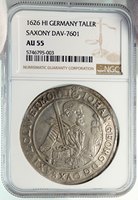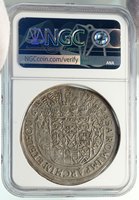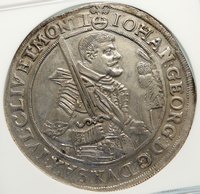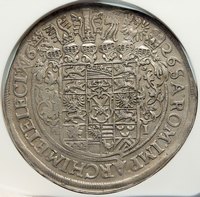Germany. German States. Electorate of Saxony
John George I (Johann Georg) - Elector of Saxony: 23 June 1611 - 8 October 1656 A.D.
Johann Georg I and August. Electors, 1611-1615
1626 HI Silver Taler 45mm (29.00 grams) (1620-1638)
Reference: KM# 132, Cl/Kahnt# 167
Certification: NGC AU 55 5746795-003
IOHAN. GEORG. D. G. DVX SAX. IVL. CLIV. ET. MONTI., Half-length armored figure to right, holding sword over right shoulder and helmet in left hand.
SA. ROM. IMP. ARCHIM. ET ELECT., Spanish shield of manifold arms (18 shields within), with central shield of electoral Saxony, 6 ornate helmets. You are bidding on the exact item pictured, provided with a Certificate of Authenticity and Lifetime Guarantee of Authenticity.
 The Electorate of Saxony (German: Kurfürstentum Sachsen, also Kursachsen) was a state of the Holy Roman Empire established when Emperor Charles IV raised the Ascanian duchy of Saxe-Wittenberg to the status of an Electorate by the Golden Bull of 1356.[1] Upon the extinction of the House of Ascania, it was feoffed to the Margraves of Meissen from the Wettin dynasty in 1423, who moved the ducal residence up the river Elbe to Dresden. After the Empire's dissolution in 1806, the Wettin Electors raised Saxony to a territorially reduced kingdom. The Electorate of Saxony (German: Kurfürstentum Sachsen, also Kursachsen) was a state of the Holy Roman Empire established when Emperor Charles IV raised the Ascanian duchy of Saxe-Wittenberg to the status of an Electorate by the Golden Bull of 1356.[1] Upon the extinction of the House of Ascania, it was feoffed to the Margraves of Meissen from the Wettin dynasty in 1423, who moved the ducal residence up the river Elbe to Dresden. After the Empire's dissolution in 1806, the Wettin Electors raised Saxony to a territorially reduced kingdom.
 John George I (German: Johann Georg I.) (5 March 1585 - 8 October 1656) was Elector of Saxony from 1611 to 1656. John George I (German: Johann Georg I.) (5 March 1585 - 8 October 1656) was Elector of Saxony from 1611 to 1656.
Born in Dresden, John George was the second son of the Elector Christian I and Sophie of Brandenburg. He belonged to the Albertine line of the House of Wettin. John George succeeded to the electorate on 23 June 1611 on the death of his elder brother, Christian II. The geographical position of the Electorate of Saxony rather than her high standing among the German Protestants gave her ruler much importance during the Thirty Years' War. At the beginning of his reign, however, the new elector took up a somewhat detached position. His personal allegiance to Lutheranism was sound, but he liked neither the growing strength of Brandenburg nor the increasing prestige of the Palatinate; the adherence of the other branches of the Saxon ruling house to Protestantism seemed to him to suggest that the head of the Electorate of Saxony should throw his weight into the other scale, and he was prepared to favour the advances of the Habsburgs and the Roman Catholic party. Thus John George was easily induced to vote for the election of Ferdinand, Archduke of Styria, as emperor in August 1619, an action which nullified the anticipated opposition of the Protestant electors. The new emperor secured the help of John George for the impending campaign in Bohemia by promising that he should be undisturbed in his possession of certain ecclesiastical lands. Carrying out his share of the bargain by occupying Silesia and Lusatia, where he displayed much clemency, the Saxon elector had thus some part in driving Frederick V, elector palatine of the Rhine, from Bohemia and in crushing Protestantism in that country, the crown of which he himself had previously refused. Gradually, however, he was made uneasy by the obvious trend of the imperial policy towards the annihilation of Protestantism, and by a dread lest the ecclesiastical lands should be taken from him; and the issue of the edict of restitution in March 1629 put the capstone to his fears. Still, although clamouring vainly for the exemption of the electorate from the area covered by the edict, John George took no decisive measures to break his alliance with the emperor. He did, indeed, in February 1631 call a meeting of Protestant princes at Leipzig, but in spite of the appeals of the preacher Matthias Hoe von Hohenegg (1580-1645) he contented himself with a formal protest. Meanwhile, Gustavus Adolphus had landed in Germany, aiming to relieve Magdeburg. Gustavus attempted to conclude an alliance with John George to allow him to cross the Elbe at Wittenberg, but John George remained hesitant to join the Protestant cause and the discussions went nowhere. Hoping that an alliance would be concluded eventually, Gustavus avoided any military action. Tilly, commander of the main imperial force, was also concerned about the possibility of an alliance, no matter how unlikely it was at the time. In order to preempt any such move, he invaded Saxony and started to ravage the countryside. This had the effect of driving John George into the alliance he had hoped to preempt, which was concluded in September 1631. The Saxon troops were present at the battle of Breitenfeld, but were routed by the imperialists, the elector himself seeking safety in flight. Nevertheless, he soon took the offensive. Marching into Bohemia the Saxons occupied Prague, but John George soon began to negotiate for peace and consequently his soldiers offered little resistance to Wallenstein, who drove them back into Saxony. However, for the present the efforts of Gustavus Adolphus prevented the elector from deserting him, but the position was changed by the death of the king at Lützen in 1632, and the refusal of Saxony to join the Protestant league under Swedish leadership. Still letting his troops fight in a desultory fashion against the imperialists, John George again negotiated for peace, and in May 1635 he concluded the important treaty of Prague with Ferdinand II. His reward was Lusatia and certain other additions of territory; the retention by his son Augustus of the archbishopric of Magdeburg; and some concessions with regard to the edict of restitution. Almost at once he declared war upon the Swedes, but in October 1636 he was beaten at Wittstock; and Saxony, ravaged impartially by both sides, was soon in a deplorable condition. At length in September 1645 the elector was compelled to agree to a truce with the Swedes, who, however, retained Leipzig; and as far as Saxony was concerned this ended the Thirty Years' War. After the peace of Westphalia, which with regard to Saxony did little more than confirm the treaty of Prague, John George died on 8 October 1656.
  Germany, officially the Federal Republic of Germany is a federal parliamentary republic in western-central Europe. It includes 16 constituent states and covers an area of 357,021 square kilometres (137,847 sq mi) with a largely temperate seasonal climate. Its capital and largest city is Berlin. With 81 million inhabitants, Germany is the most populous member state in the European Union. After the United States, it is the second most popular migration destination in the world. Germany, officially the Federal Republic of Germany is a federal parliamentary republic in western-central Europe. It includes 16 constituent states and covers an area of 357,021 square kilometres (137,847 sq mi) with a largely temperate seasonal climate. Its capital and largest city is Berlin. With 81 million inhabitants, Germany is the most populous member state in the European Union. After the United States, it is the second most popular migration destination in the world.
Various Germanic tribes have occupied northern Germany since classical antiquity. A region named Germania was documented before 100 CE. During the Migration Period the Germanic tribes expanded southward. Beginning in the 10th century, German territories formed a central part of the Holy Roman Empire. During the 16th century, northern German regions became the centre of the Protestant Reformation. The rise of Pan-Germanism inside the German Confederation resulted in the unification of most of the German states in 1871 into the Prussian-dominated German Empire. After World War I and the German Revolution of 1918-1919, the Empire was replaced by the parliamentary Weimar Republic. The establishment of the Third Reich in 1933 led to World War II and the Holocaust. After 1945, Germany split into two states, East Germany and West Germany. In 1990, the country was reunified.  In the 21st century, Germany is a great power and has the world's fourth-largest economy by nominal GDP, as well as the fifth-largest by PPP. As a global leader in several industrial and technological sectors, it is both the world's third-largest exporter and importer of goods. Germany is a developed country with a very high standard of living sustained by a skilled and productive society. It upholds a social security and universal health care system, environmental protection and a tuition free university education. In the 21st century, Germany is a great power and has the world's fourth-largest economy by nominal GDP, as well as the fifth-largest by PPP. As a global leader in several industrial and technological sectors, it is both the world's third-largest exporter and importer of goods. Germany is a developed country with a very high standard of living sustained by a skilled and productive society. It upholds a social security and universal health care system, environmental protection and a tuition free university education.
Germany was a founding member of the European Union in 1993. It is part of the Schengen Area, and became a co-founder of the Eurozone in 1999. Germany is a member of the United Nations, NATO, the G8, the G20, and the OECD. The national military expenditure is the 9th highest in the world. Known for its rich cultural history, Germany has been continuously the home of influential artists, philosophers, musicians, sportsmen, entrepreneurs, scientists and inventors.
|




 The Electorate of Saxony (German: Kurfürstentum Sachsen, also Kursachsen) was a state of the Holy Roman Empire established when Emperor Charles IV raised the Ascanian duchy of Saxe-Wittenberg to the status of an Electorate by the Golden Bull of 1356.[1] Upon the extinction of the House of Ascania, it was feoffed to the Margraves of Meissen from the Wettin dynasty in 1423, who moved the ducal residence up the river Elbe to Dresden. After the Empire's dissolution in 1806, the Wettin Electors raised Saxony to a territorially reduced kingdom.
The Electorate of Saxony (German: Kurfürstentum Sachsen, also Kursachsen) was a state of the Holy Roman Empire established when Emperor Charles IV raised the Ascanian duchy of Saxe-Wittenberg to the status of an Electorate by the Golden Bull of 1356.[1] Upon the extinction of the House of Ascania, it was feoffed to the Margraves of Meissen from the Wettin dynasty in 1423, who moved the ducal residence up the river Elbe to Dresden. After the Empire's dissolution in 1806, the Wettin Electors raised Saxony to a territorially reduced kingdom. John George I (German: Johann Georg I.) (5 March 1585 - 8 October 1656) was Elector of Saxony from 1611 to 1656.
John George I (German: Johann Georg I.) (5 March 1585 - 8 October 1656) was Elector of Saxony from 1611 to 1656. 
 Germany, officially the Federal Republic of Germany is a federal parliamentary republic in western-central Europe. It includes 16 constituent states and covers an area of 357,021 square kilometres (137,847 sq mi) with a largely temperate seasonal climate. Its capital and largest city is Berlin. With 81 million inhabitants, Germany is the most populous member state in the European Union. After the United States, it is the second most popular migration destination in the world.
Germany, officially the Federal Republic of Germany is a federal parliamentary republic in western-central Europe. It includes 16 constituent states and covers an area of 357,021 square kilometres (137,847 sq mi) with a largely temperate seasonal climate. Its capital and largest city is Berlin. With 81 million inhabitants, Germany is the most populous member state in the European Union. After the United States, it is the second most popular migration destination in the world. In the 21st century, Germany is a great power and has the world's fourth-largest economy by nominal GDP, as well as the fifth-largest by PPP. As a global leader in several industrial and technological sectors, it is both the world's third-largest exporter and importer of goods. Germany is a developed country with a very high standard of living sustained by a skilled and productive society. It upholds a social security and universal health care system, environmental protection and a tuition free university education.
In the 21st century, Germany is a great power and has the world's fourth-largest economy by nominal GDP, as well as the fifth-largest by PPP. As a global leader in several industrial and technological sectors, it is both the world's third-largest exporter and importer of goods. Germany is a developed country with a very high standard of living sustained by a skilled and productive society. It upholds a social security and universal health care system, environmental protection and a tuition free university education.
